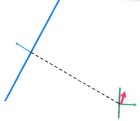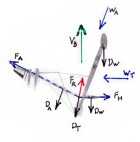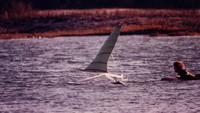High-Speed Sailing
| Vessel Name: | Sailien |
| Vessel Make/Model: | Experimental/custom |
28 September 2013
The America’s Cup
I watched, with interest, the videos of the 34th America’s Cup. At last we have fast sailboats engaged in a competition that is fun to watch. The virtual images (such as course boundaries, distance grid lines, separation between boats, etc.) overlaid on the real images really helps to keep the race [...]
31 August 2013
100 Knots for Hydroptere?
The latest news from Hydroptere is that they have plans for a 100 knot sailboat. This was posted on 26 Aug 2013, so look for that date at this address. http://hydroptere.com/en/the-news/last-news/
17 November 2012
Aptly named Sailrocket, blasts off!
While yet to be ratified, Sailrocket posted an average speed over 500 meters of 59 knots. I will not be surprised if they increase their record into the 60 knot range during this record attempt.
02 January 2012
More drag for VSR2?
I want to start by pointing out that the whole VSR2 team has done a stellar job and has demonstrated conclusively that the forces that drive a sailboat can be aligned for roll stability without using ballast and without using any down-force. (Trifoiler achieved roll stability by using down-force, but [...]
18 December 2011
My analysis of Sailrocket
I copied a diagram of VSR2 (wing doesn’t show well) and added in the major force arrows that apply. Be aware that these arrows are not correct in terms of scale (length) and some of their locations are guesses, however I believe I’m correct enough for us to learn something about what VSR2 has been [...]
23 October 2011
60 is within reach, what’s next?
I have been watching Sailrocket’s progress with great interest and there’s no question they have a winner. I fully expect to see them reach 60kt in the near future. Sailrocket has now demonstrated what I first learned with my models and again with my full-sized prototypes, that if you get the forces [...]
The state of Sailien
I would dream about perfect un-crowded waves in remote lands. Many such waves are not accessible by land, meanwhile travel and living expenses take a real bite, unless you're independently wealthy. Well, all the surf-spots are accessible by sea, so a live-aboard ocean cruiser is an obvious choice. A power boat is out of the question, unless you own an oil well, but a sailboat is ideal. Only trouble, I considered a sailboat to be too slow, so things stalemated at that point. But I had a copy of Bernard Smith's "The 40 Knot Sailboat" and another "life" (inventor) said "Why not?"
Over the years, I developed Sailien, gaining an understanding of pitch, roll and yaw as applies to a sailboat. These three motions have to be under total control at all times in a high-speed sailboat or you will "lose it" (usually resulting in a crash). I have these three motions under control, embodied in the models and full-size prototypes of Sailien and, because of my experience with this; I can easily see what is going on with any other sail craft. Apparently, the ability to "see" how the forces interrelate with the parts of any sailboat at a basic core level is my strong point. This is why I've been able to write this blog (the posts have not been altered once they were finalized so you can check out my accuracy).
So what's needed to set the sailing record? Simple, just build a sexy looking craft and kick all the other sailors butts! In real-world terms what does this mean? It's going to take some clever engineering and construction as well as necessary support logistics.
Here's what's needed (I'm capable of learning and doing any of this, but it would just take too long):
Structural engineering: the craft has to be extremely light and very strong, this means composites.
Fluid dynamics: both our aero and hydro dynamics have to be the best possible.
Construction: carbon fiber, epoxy, probably honeycomb cores, vacuum bagging, and ideally an autoclave to cure the parts.
Materials: we either raise the money to buy them or we get them donated, either way it takes a "sales" job.
Machining: my control mechanisms are unique to what I'm doing and I've had to design and build them (by hand) they will need to be precision, strong and light.
Logistics: we will need a venue for testing and later one for the actual speed runs. This will take a certain amount of funding.
Odds and ends: all the details I left out.
Any of you want to join me? (Thanks John, you're in.) The first thing I'm looking for is interest in and enthusiasm for the project. With enough interest from enough people, we can put the rest together. Naturally any of you qualified in the above listed areas will be a big boon, also if you know qualified people, spread the word.
I've been advised that I should be cheeky, insouciant, brazen, etc. so here it is:
Look out high-speed sailors, we're going to show you how it's done, then I'll write it down so you can learn how.
Bob
About & Links
- Bob's Surfing Blog
- Bob's Website
- Greenbird (Windjet)
- l'Hydroptere
- Le Projet Dared
- Macquarie Speed Sailing Team
- Monofoil Sailing
- Mountain Goat STOL
- Mr Smith's Amazing Sailboats
- Patent Office (Search)
- Radboat
- Sailien Prototypes (early), Delta, etc.
- Sailien Video
- Sailien Website
- The Basics of Surfboard Design
- The Basics of Surfboard Design en Espanol
- The Swedish Speed-Sailing Challenge
- Trifoiler
- Vestas Sailrocket
- Windjet Project
- WSSRC


